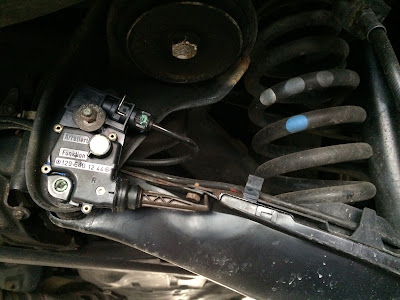The sound of the impact startled me. I didn't even see it coming. There I was driving on the highway in the middle of the day with perfect visibility and ideal road conditions. Perfect, except for that foreign object I had just hit underneath my car.
Sounds simple enough, but this procedure perplexed me for a couple of weeks because I had skipped over step #5, so the roll bar kept deploying. You need to set it off in the test setting, then change the setting back to normal only after you've triggered it.
I very quickly learned two things. First, the leaves jammed in and around the passenger-side rear control arm told me I had likely run over a tree branch. And second, that branch damaged the passenger-side rear axle limit switch. This is the switch that triggers the rear headrests/roll bar when the car is in danger of flipping over. As a result, the roll bar had become hyper-sensitive, deploying upwards in a loud and jarring POP over pot holes and hard turns. Otherwise, the car was undamaged.
My first call was to The Classic Center for the two parts—the rear axle limit switch (129 540 1244) and the control arm cover. Both parts are still available new, though the cover now has a different part number (203-352-00-88) and is no longer a 129 part. In fact, since the cover was a mere $6.80, I decided to replace the left cover as well since it's held in by just two screws. (FYI, the rear axle limit switch was $95.20.) You'll recall from previous blog postings that I'm in the process of tidying up the undercarriage, so this was purely a cosmetic issue.
 |
| Note how the hook-like extension on the switch is just touching the control arm cover |
Now comes the tricky part. To change this part, you have to:
- Lower the rear head rests if they've deployed. Hold down the rocker switch on the dashboard in the UP position until you hear it click. (About 8 seconds, I believe.) Then change directions and push the button in the DOWN direction to lower them. (By the way, to do this after they've deployed, you have to shut the car off, then re-start it before going through this routine.)
- Put the car on either a lift or on jack stands so both rear wheels are off the ground. The rear suspension needs to be resting on its own weight and not the ground.
- Install the rear axle limit switch so that the hook-like extension is just barely touching the control arm cover.
- Set the switch to the test setting ("arretiert") and make sure it's installed securely.
- Lower the car and take it for a test drive. You'll need to deploy the roll bar, so you'll have to either stop abruptly or corner fairly aggressively to trigger the mechanism.
- Once you've successfully deployed the roll bar, you'll need to repeat step #1 to re-set and lower the bar.
- Finally, crawl underneath the vehicle and set the limit switch to the drive setting. In other words, move the switch from "arretiert" to "funktion."
This is yet another feature borrowed from the R129 roadsters from the mid-90s. They have an actual roll bar that pops up, but the triggering mechanism is the exact same part.
Comments
Post a Comment